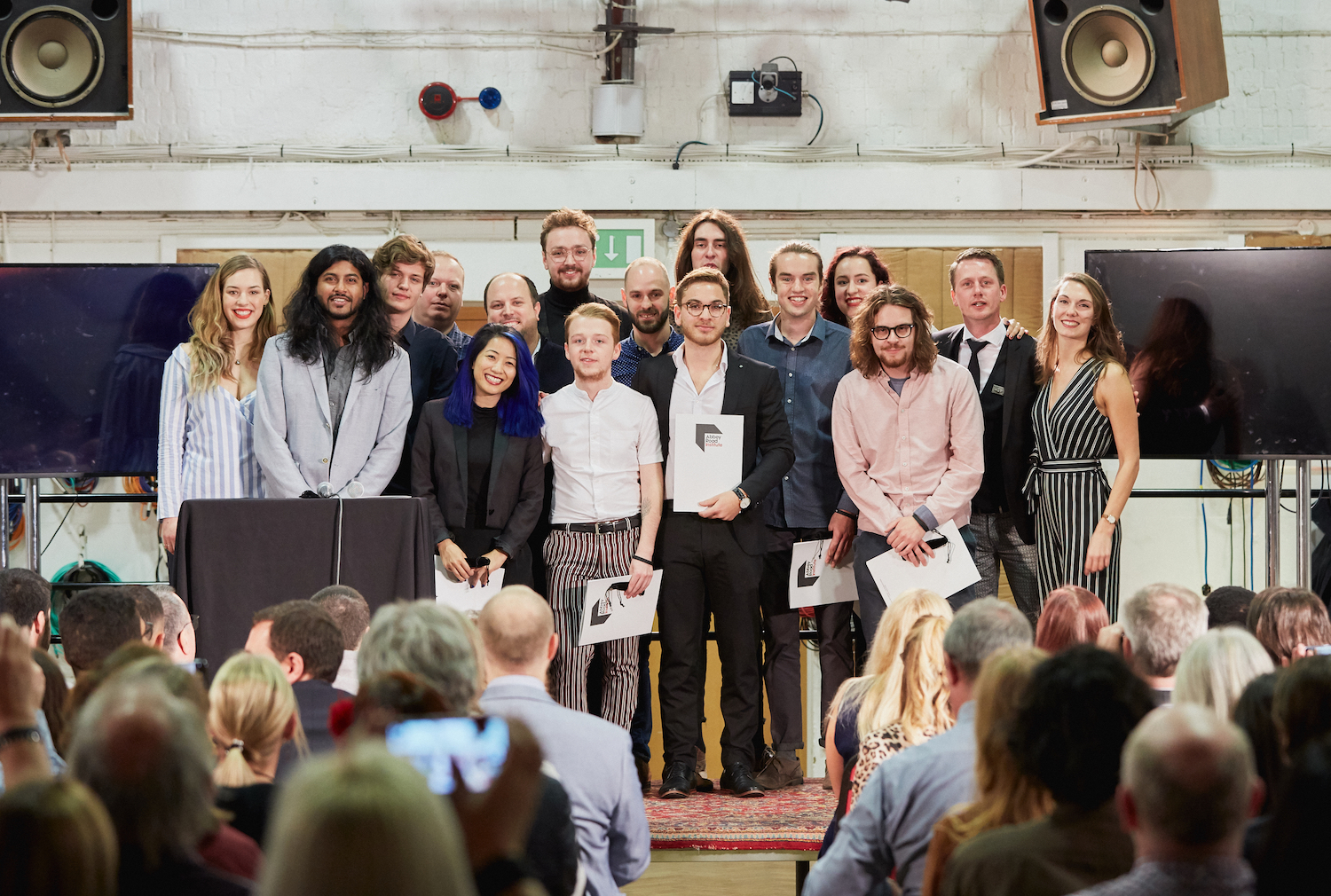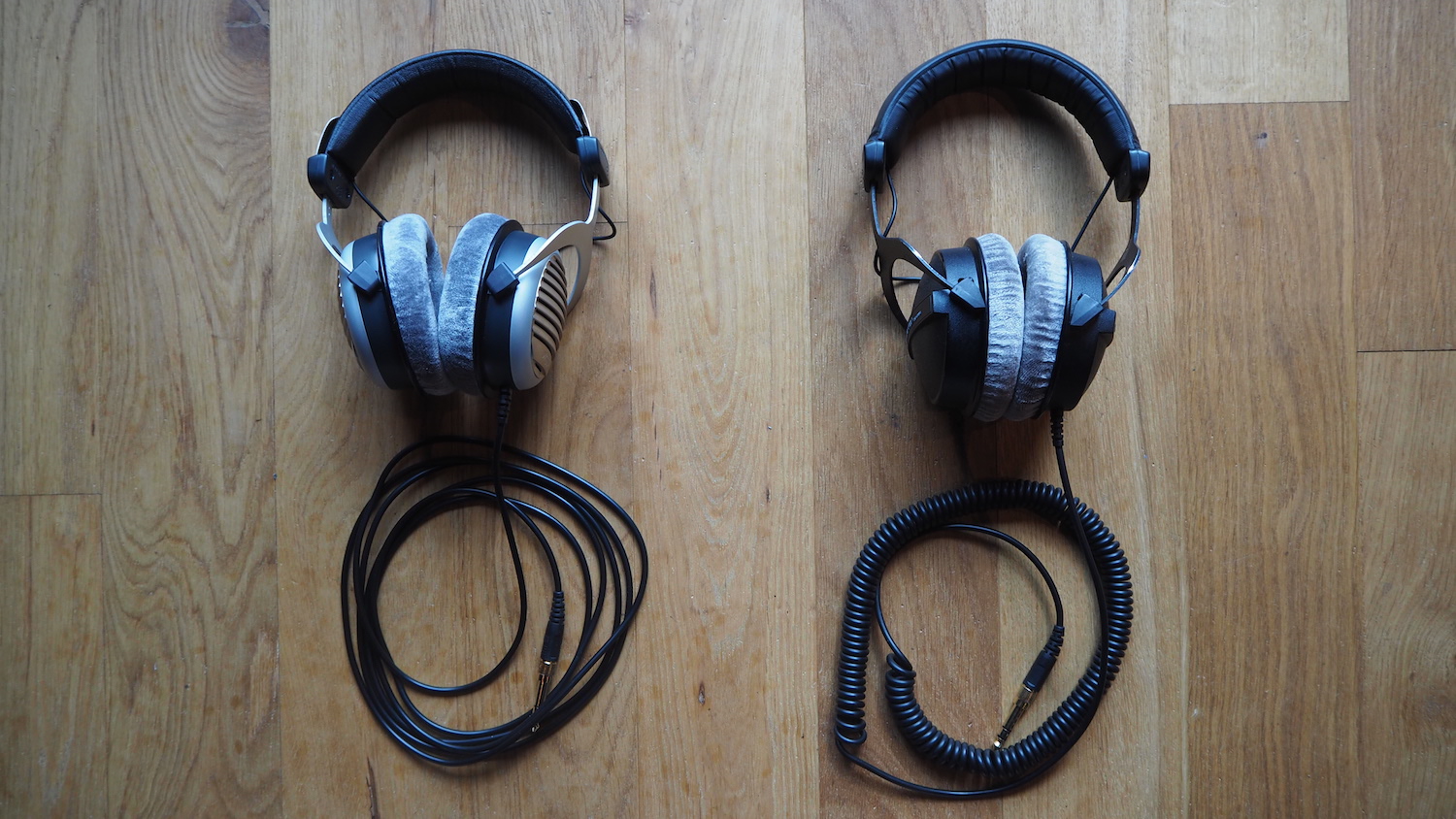
REVIEW: nuraphone headphone + best alternatives
I recently checked out the Nura nuraphone headphone, which is the first in the world to adapt to each individual’s hearing. My conclusion: do NOT buy nuraphone. In this blog post I will tell you my disappointing experience with nuraphone and list the best alternatives in the same price range.
I recently checked out the Nura nuraphone headphone, which is the first in the world to adapt to an individual’s hearing. My conclusion: do NOT buy nuraphone. It’s HYPE. It’s not worth it. In this blog post I will tell you my disappointing experience with nuraphone and list the best noise-cancelling wireless headphone alternatives in the same price range.
Buy Nura nuraphone €399 EUR
https://thmn.to/thoprod/453651?offid=1&affid=1766
Buy Bowers & Wilkins PX Space Grey €399 EUR
https://www.thomann.de/intl/bowers_wilkins_px_space_grey.htm
Bowers & Wilkins PX Soft Gold €399 EUR
https://www.thomann.de/intl/bowers_wilkins_px_soft_gold.htm
Buy Sony WH-1000XM3 Black €369 EUR
https://www.thomann.de/intl/sony_wh_1000xm3_black.htm
I first discovered The Nura nuraphone from an Instagram sponsored ad. I was curious so I went to their website. By chance, I saw a friend’s Instagram photo and a positive review, so I messaged that friend about her experience. She said she’d discovered them and backed the fellow Melburnians on Kickstarter. She said she was really happy with the headphones and both her and her husband had a pair, each with their own profile. She tried his profile, but liked hers better.
Fast forward a few months later, and I was in Melbourne. I saw some outdoor advertising and one day, I bumped into the Nura pop-up store in a shopping mall. Very curious, I went to see if the nuraphone was really revolutionary.
Design: First impressions of the design were good. It had a sleek minimal black design which doesn’t really stand out, but headphones don’t need to, so it’s a personal taste. I liked the idea of the ear buds with additional ear cups. This is something I haven’t seen before and they are really comfortable.
Build: The build is quite ok. It’s not flimsy cheap plastic and has a good weight to them.
Sound Profile: Then I was asked to make my profile with the app on a phone. I put the headphones on and the calibration began. Noises from all frequencies bounced around my ears and it took a while for it to finish. Then, voila! There was my profile. Represented in beautiful colours.
Then I was asked to listen to the reference song without my profile, and then with. This is where my biggest concern is. The reference without the profile was suspiciously very bad, in many ways. And then, comparing to when your profile is on, is of course a huge difference, and has the “wow effect”, but I think the non-calibrated setting should be already a fantastic listening experience and the profile tweaks to perfection. This way, you know they’ve done it on purpose for the untrained ear to be impressed by their profiling. My profile had a lot of excitement. A very boosted high end which I didn’t like (very sharp/brittle), clear mids and pumpy bass. It’s obvious that the sound is supposed to excite, but for me I prefer something more honest or pure, otherwise my ears get tired pretty quickly). And honest doesn’t mean dull. One thing I started thinking about: since they can manipulate my profile, why can’t I? And if I can, what’s the point of the revolutionary ear adaptation?
I recently bought the Sonarworks Reference 4 which let’s you listen to tracks without colouration through picking your headphones from the list and the plugin neutralises the boosts and troughs. Once I used it on my Beyerdynamic DT 990 Edition headphones I was so happy with the result. A good quality headphone without colouration gives such an amazing listening experience. Call me a boring music producer who has to listen to everything “as is”, but this is how it should be. As honest and clear as possible. There’s no room for listening fatigue then. (Does this mean I am an audiophile?")
Summary: I believe the nuraphone headphones have some really great features, such as design and the noise cancelling is really good, but for audiophiles (or noobs who need advice) wanting the highest quality listening experience for that price, you can better buy headphones from another brand.
Alternatives of noise-cancelling wireless headphones in the same price bracket (€350 - €400):
Bowers & Wilkins PX is my best recommendation for high detailed quality, awesome stereo and spacial depth for the same price as the nuraphone. Comes in Space Grey or Soft Gold. NOTE: however, the ear cups feel a bit funny because of their shape, so it’s definitely not for everyone.
Sony WH-1000XM3 is my second tip in case you don’t like the B&W. It seems to be very popular choice.
Bose QuietComfort 35II is a third option, however I didn’t really like it. It has a boosted bass and I just didn’t like the sound.
Buy Nura nuraphone €399 EUR
https://thmn.to/thoprod/453651?offid=1&affid=1766
Buy Bowers & Wilkins PX Space Grey €399 EUR
https://www.thomann.de/intl/bowers_wilkins_px_space_grey.htm
Bowers & Wilkins PX Soft Gold €399 EUR
https://www.thomann.de/intl/bowers_wilkins_px_soft_gold.htm
Buy Sony WH-1000XM3 Black €369 EUR
https://www.thomann.de/intl/sony_wh_1000xm3_black.htm
—
If you’ve reached this far down of my blog post, please take a few seconds to:
Subscribe to my YouTube
Follow my Instagram
Like my Facebook
REVIEW: Abbey Road Institute Amsterdam (my personal experience)
Both during and after my one year at Abbey Road Institute Amsterdam studying the Advanced Diploma Music Production & Sound Engineering, I have been asked several times by friends and strangers alike about my experience at the course. So, I have decided to create a comprehensive overview of my experience, so that other prospective students can get to know a bit more about the course first-hand from a graduated student.
Both during and after my one year at Abbey Road Institute Amsterdam studying the Advanced Diploma Music Production & Sound Engineering, I have been asked several times by friends and strangers alike about my experience at the course. So, I have decided to create a comprehensive overview of my experience, so that other prospective students can get to know a bit more about the course first-hand from a graduated student. It seems that I am somehow an ambassador and credible source for the school, which is confirmed by my friends’ messages below:
Messages from friends on Instagram and Facebook that they have seen me on Abbey Road Institute sponsored posts
Here are a list of the most frequently asked questions, with their answers below. I will update this page if I get additional questions!
DISCLAIMER: I only have insight into the Amsterdam school and each campus is different with what they offer. Also, these are the insights into the full time course September 2017-2018, and courses before and after this may not be entirely the same.
FAQ
Are you happy with Abbey Road Institute / the course?
YES, absolutely. The first time I had contact with the school was with Milou by chat and she followed up by email and invited me to visit the school and participate as a student for a day. After visiting the school and sitting in, I knew immediately it was the right place for me. It felt very casual, warm, inclusive and everything was of a very high quality. And when I attended the course, my views did not change. Everyone was supportive and passionate, teachers and students alike. We were a class of 20, from ages 16-40, gender split of 17 boys and 3 girls, and people from all over the world including Australia, Bangladesh, USA, Curaçao and other parts of Europe. Felt like a family and even after I’ve left, I feel that I have made a network for life.
I wanted to know if you thought your course was a worthwhile investment?
For me the education was 100% worth it, as I could change my career from Social Media Manager for Adidas to Music Producer in one year which is very fast. I’m far from a pro but without the education it was almost impossible to do such a switch and be confident that quickly.
Good to note for mature-age students: since I had a full-time salary that same year, I was able to claim back a significant proportion of the course fee from the tax office as a tax deduction. It is possible to claim up to 52% of the course fee depending on which income bracket you are in.
How would you describe the application process?
For Amsterdam, application process is easy: just submit a few songs that you have made or have been involved in and a small interview. They were not strict on your background in music theory or playing an instrument but the students who lacked in these areas struggled a lot in music production topics.
How would you describe the education as a whole?
The Amsterdam campus is heavily focused on audio engineering. My teachers were mainly a group who studied and taught at SAE so in first term we focused on mixing, second term recording (microphone techniques and using analogue console), and third term music business, film. We also did other topics like synths, mastering, programming, live sound, and a bunch of others but I wouldn’t say it was the focus.
We learnt DAWs Pro Tools, Logic and Ableton in that order and also order of importance. They set you up to work in a professional recording studio.
PLUS POINTS
The equipment we could use was amazing. The studios, analogue consoles (Neve VR console & SSL 8000 G+/B console), speakers (PMC, Dynaudio) iMac computer, UAD Apollo Twin audio interface per working station, software (including UAD plugins, Fabfilter, Softube, iZotope, Celemony), outboard gear (Universal Audio 1176, Pultec, Tube-Tech, Lexicon reverb, Manley Massive Passive EQ, Crane Song compressor, Dimension D chorus, Eventide Harmonizer, Binson Echorec), 100 m² live room with guitars (electric and acoustic), basses, amps, Rhodes, Steinway grand piano, Hammond organ, a couple synths, and top microphone selection including many vintage Neumann U87, U89, U47 and top studio mics such as Schoeps CMC6, Sennheiser MD421 & SM7B, AKG C414, Neumann KM84 and more.
We had a lot of guest speakers, who were really good at what they do, and known in the industry. Al Schmitt came to our school! So in terms of getting face to face contact with these people was so precious. It’s not like paying for a ticket to a conference and hassling the speaker afterwards to get them to notice you. Everyone who came to talk or give a masterclass or workshop are friends with our teachers so we were also treated as family, or friends of friends. Always felt welcome to ask anything and keep in touch afterwards. Very good way to get connected and enter the network.
We had the chance to apply for an internship at Red Bull Studios which I got so I’ve been working as assistant recording engineer for some really cool sessions. I love it! (Unpaid but worth it)
We also went to visit a lot of great studios including Rockfield in Wales and other studios in Belgium and The Netherlands. And graduating at Abbey Road Studios was definitely a highlight!
We also had free tickets to conferences such as Dancefair and some stuff at Amsterdam Dance Event.
MINUS POINTS
It is a very expensive course.. if you do the full time course (one year) it’s impossible to work on the side. So you need a lot of savings to finance the course and your living. I can recommend the part-time course if you have a source of income on the side or you can afford two years. You then have more time to soak in what you learn and book the studio for 2 years! By the 6th month, I still was not really ready to record bands, so I wasted a lot of precious studio time because of this.
The full time class (in Amsterdam) is with 20 people. In my opinion it’s too many. Of course there were drop outs and people who did not turn up to class, but a class of 15 would be better. I say this because from a class of 20, we only had 15 graduating students, which is only 75%. One student from the part-time class said with only 10 people he feels more pressure, because he doesn’t want to be the only one in the class to fail an exam. So the bar is higher. And with 20 full-time students, and almost 20 part-time students combined, it gets hard to book studio time, since there are only 3 studios.
There was not a huge focus on how to become a music producer, like the type that works with singers and creates the music and beats in the box. Most people aspire to be a music producer, not a recording engineer, which is the sign of the times. It would have been great to dissect some productions of famous producers like Max Martin and understand the arrangement, electronic sounds like this analysis by Rick Beato on Max Martin’s production techniques on Ariana Grande’s song Into You. In that sense, the schooling was very traditional and no one was being groomed to be the next Martin Garrix by attending the school.
Do you think there are possibilities of further networking through the course?
We had a lot of masterclasses and excursions with big names in the industry, something you cannot get if you visit a conference or as as individual. So networking is a big plus.
Do you already have a plan for what comes after you have graduated? My parents are worried that I might not get a job and can’t pay my own rent after doing this. What is your opinion?
With every study there's always doubt whether you'll get a job or not. I know the course fee is super expensive so the investment is very high..
We will all get a good base to go into any direction we want. The teachers are all very young, inspiring and experienced, not all are good "teachers", but it is compensated by their industry experience. They've been there, done that, or currently doing it.
The facilities here are just excellent. It's totally new, and we study in a professional studios. The equipment is top class.
I don't know exactly which direction I'll go when I'm done, but since I came from a marketing/advertising background I'll probably go into producing music for commercials. I have some contacts in this fields.
The other thing is that you can only learn so much in 1 year, so it's up to you to work on your own music and collaborate as much as possible outside of class hours. This is how you can build up your portfolio and get a job after graduation.
It's not going to guarantee a job just by attending the school. If you're dedicated and you make the most of the facilities and work hard on your portfolio, and build up a good circle of contacts in your network, you can surely have a better chance to get paid work or an internship after graduation.
Who is this course for / not for?
This course is for people with a lot of passion and self-discipline. They teach you the basics and it’s up to you to motivate yourself to practice the things you learn in class, read up more, watch more YouTube etc. So the material you learn is like a small springboard and you have to do the deep diving yourself. In the first term we had mixing assignments to complete every week, but in second and third term we could use the time after class how we wanted.
This course is not for people who do not know any music theory AND cannot play an instrument at all. Of course it is not impossible to attend the course if the above is you, but if you don’t play an instrument, at least try to know the basics of music theory before attending, which will help. A person with an untrained musical ear has a huge disadvantage, because learning to hear compression, different frequencies, different nuances of microphones and phase issues can be very demanding.
What are the exams / assessments like?
There are a mix of assessments and exams per term. The first term there was a Pro Tools production and Logic assignment, along with multiple choice sound theory test, in-class Pro Tools and in-class Logic exams. There are also weekly mixing assignments, which are not officially graded, but feedback is given.
The second term there is an Advanced production assignment using Ableton, along with multiple choice test, in-class Pro Tools and in-class Logic exams.
The third term was the most demanding, and consisted of an Advanced recording assignment, along with short-answer test, business plan, and studio exam.
The assessments are demanding and the grading is very strict. Don’t expect to pass every exam! That’s what they told us in the beginning :-D
What job can I get after the course?
This course will prepare you very well for the following jobs:
recording engineer,
mixing engineer,
music producer (recording studio)
(eventually mastering engineer but do not come to this school to learn in-depth mastering),
audio editor,
post-production engineer,
studio owner
Jobs that the course can lead to, but does not specialise:
sound designer,
film / game / advertising composer,
live sound engineer,
session musician,
record label /publisher / booking agency owner
entrepreneur
beat maker
HIGHLIGHTS IN PHOTOS
Meeting one of the most legendary recording engineers still alive (and of all time): Al Schmitt!
At Rockfield Studios in Wales, where Bohemian Rhapsody was recorded!
In Studio 2, Abbey Road Studios in London, graduation ceremony
Outside Abbey Road Studios in London, graduation ceremony
IN SUMMARY
So, if you have made it down this far, now for the summary… this course gives you a bit of this and a bit of that, but overall it is quite a generalist course with a focus on audio engineering. See it as a springboard to get started or if you come from another angle of the industry, you can hone your engineering skills. In the end, it is up to you to decide what you want to do afterwards. There is no hand-holding in this regard and it’s your own determination that will get you to the next step.
If you have any questions or comments, feel free to drop a note below.
Staff:
Robin Reumers (director of education)
Jasper Derksen (managing director)
Milou Derksen (studio manager and go-to-woman for everything)
Main Teachers:
Emiliano Caballero (mixing, production)
Anthony Maes (recording techniques, analogue consoles, Pro Tools)
Nick Ribbens (Logic Pro X)
Marco Spaventi (Ableton Live 10, synthesis, sampling, remix)
Robin Reumers (sound theory, acoustics)
Erwin Palper (electronics)
Rob Mostert (aural training)
Robin Freeman (music history)
Tobias Hess (arrangement, music theory)
Guest speakers (select):
Al Schmitt (recording engineer)
Luca Pretolesi (producer)
Focus… (producer)
Jef Martens / Basto (producer)
Idan Altman (indie music producer)
Huub Reijnders (producer)
David Miles Huber (producer)
Wessel Oltheten (producer, author mixen met impact)
Darcy Proper (mastering engineer)
David Pattillo / Strange Majik (producer)
Eddy Koopman (percussionist/producer, Metropole Orkest)
Jimmy van den Nieuwenhuizen (session drummer)
Bas Nuiver (bassist)
Gabi Martinez (session guitarist)
Tijs van Liemt (A&R Manager, Universal Music NL)
Joris van Welsen (founder Radar agency, booking and management)
Minke McKenna (founder Mink Records)
Natalia Ramírez (vocal tuning, audio engineer)
Bindu De Knock (lawyer creative industries)
Mark Derksen (founder Markant Studios)
Jeroen Dreessen (director operations, Leapwing)
Studios we visited:
Abbey Road Studios (most famous recording studio in history, London, UK)
Rockfield Studios (most rock’n’roll studio in history, Wales, UK)
Wisseloord Studios (Hilversum, NL)
Galaxy Studios (film post-production, Belgium)
Studio 150 Bethlehemkerk (Amsterdam, NL)
Power Sound Studio (Amsterdam. NL)
Markant Studios (Heeze, NL)
WarnierPosta (audio post-production, Amsterdam, NL)
Motormusic (Belgium)
Events we had guest-list access to:
Dancefair, Utrecht
Revealed Day Conference (ADE), Amsterdam
—
If you’ve reached this far down of my blog post, please take a few seconds to:
Subscribe to my YouTube
Follow my Instagram
Like my Facebook
GIG REVIEW: Tash Sultana at AFAS Live
It’s not the first time Tash has toured The Netherlands. She already toured last year at a smaller venue but I missed out. This year though, I got lucky, because my friend Liloe Rix bought me a ticket for my birthday!
A friend from Melbourne told me about Tash Sultana a couple years ago, and she showed me the live bedroom recording of Jungle on YouTube. I still remember that we were paying for our brunch at a café (one of the Beany Greens) in London and I was impressed immediately!
It’s not the first time Tash has toured The Netherlands. She already toured last year at a smaller venue but I missed out. This year though, I got lucky, because my friend Liloe Rix bought me a ticket for my birthday!
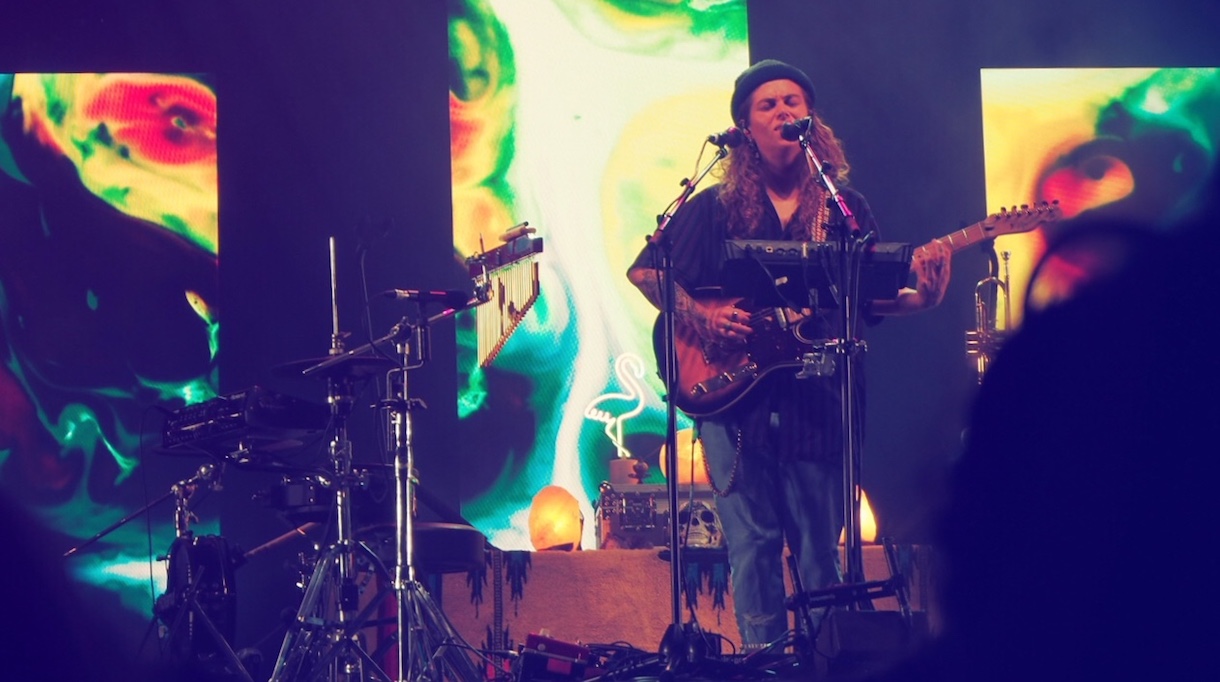


Pierce Brothers were the support act. They were like the extraverted younger cousins of Xavier Rudd and John Butler with didgeridoo, stomp box, open tuning and a hint of Walk Off The Earth with the two hands/one fretboard coordination. SO much energy! And audience participation.. it’s hard to be a support act, but they definitely proved themselves a solid musical duo capable of warming up the crowd for Tash Sultana.
But we were there for Tash. A one-woman show with acoustic and electric guitars, banjo, trumpet, pan flute (which she said was the best 50 cents she had every spent in Thailand), synths, drum pads, loops, effects pedals and more equipment I wish I could get a closer glimpse of! My favourite was her octaver though, I really want to know which one she used, because it sounded so subby on her voice and guitar.
The audience was really chill. She remarked that it was great that her audience was made up of all types, not just one gender, race or age. I noticed a lot of young people. generally more girls than boys, many girl couples, and a very international crowd which was why I saw many girls who were on the shorter side. Usually at a concert full of Dutch people I’m trying to see through armpits. Tash herself has a bit of a hippy vibe, with an Indian pattern blanket covering her synths, playing barefoot, salt-rock light holders and incense that for a while was strong, until all I could smell was weed. I have no idea where that was coming from!
She set out her ‘rules’ very quickly after her opening song. They were: 1. If you’re homophobic, get the fuck out of here. 2. If you’re racist, get the fuck out of here. 3. If you’re transphobic, get the fuck out of here.
There was a lot of live looping and improvising, and a lot of smiles from her! Tash was having so much fun on stage! The crowd was incredibly quiet and respectful (at least where I was standing), which is very rare for Dutch crowds, who are usually hands full of beer, loud and aggressive. Having said that, Tash said that the Dutch audience was so ‘polite’, and she said she hadn’t had a bra thrown at her yet, or in South America there were people trying to get into her hotel room at 4am.. wtf.
She played for a total of 2 hours without much of a break. She performed tracks from her latest Flow State album, which has more synths than her previous stuff which is guitar-based.
It was easy to get in a trance while listening to the songs. At some point I got lost in which song I was listening to, and some of them blurred into one another, indeed like a flow state. When she performed Jungle, the song on YouTube that has now 21M views, I saw a lot of phones starting to record, which I hadn’t seen too many phones previously. This crowd was really chill, like I said. And at a certain point, when there was the break of the song, I looked around, and I saw a lot of people smiling, some closing their eyes, but simultaneously smiling and enjoying the same moment altogether. It was such a magical moment.
Tash said she would be playing at Ziggo Dome next year, which is an even bigger stadium. That’s so great for her! Just a girl, once busking on Bourke street in Melbourne, to filling up stadiums around the world.. what an inspiration.
More about Tash Sultana:
Official Website: http://www.tashsultana.com/
Facebook: https://www.facebook.com/tashsultanamusic/
Spotify: https://open.spotify.com/artist/6zVFRTB0Y1whWyH7ZNmywf
If you’ve reached this far down of my blog post, please take a few seconds to:
Subscribe to my YouTube
Follow my Instagram
Like my Facebook
REVIEW: Beyerdynamic DT 770 vs. DT 990 headphones
Are you looking for a good quality headphone for recording, mixing and mastering at a good price? Maybe you’ve heard about Beyerdynamic DT series and don’t understand the differences. So I’m going to compare the Beyerdynamic DT 770 Pro 250 Ohm (closed) and DT 990 Edition 250 Ohm (open) and tell you which one I use for which purpose.
Are you looking for a good quality headphone for recording, mixing and mastering at a good price? Maybe you’ve heard about Beyerdynamic DT series and don’t understand the differences. So I’m going to compare the Beyerdynamic DT 770 Pro 250 Ohm (closed) and DT 990 Edition 250 Ohm (open) and tell you which one I use for which purpose.
Buy the DT 770 Pro 250 Ohm: https://redir.love/vUOBW8oN
Buy the DT 990 Edition 250 Ohm: https://redir.love/qM1im3YD (not available anymore on Thomann but take a look at other products)
[Before I start, I’d like to say why I am reviewing the DT 990 Edition and not the DT 990 Pro. The DT 990 Edition was released as a “home” listening headphone for high-end audio speakers, however, on their website, they say that both DT 990 headphones use exactly the same technology inside, so the only difference is aesthetically (1. the straight vs. coiled cable, 2. softer headband on Edition, and 3. colour). I preferred the straight cable so it was a no brainer.]
Now, back to the comparison of 770 and 990. First I’d like to point out the similarities:
SIMILARITIES BETWEEN DT 770 250 Ohm and DT 990 250 Ohm
Comfort. Both headphones are incredibly comfortable to wear over the ears. Spongy ear cups and the headband is not too tight.
Soundwise, both are very clear and crisp in sound. The bass is not exaggerated like in some other headphones, so for listening and mixing pleasure, it’s rather suitable for acoustic music, and not music where the bass is key e.g. electronic music/hip hop. Frequency-wise, they both sound pretty similar to me.
Price. For the quality of the headphones, the price is very good. Good quality headphones can go up to 1000s of Euros along with headphone amps and other high-end stuff, but these are both studio-grade headphones and the DT 770 Pro is a standard in good recording studios for tracking (we use them at Abbey Road Institute (Amsterdam) and Red Bull Studios Amsterdam).
DIFFERENCES BETWEEN DT 770 250 Ohm and DT 990 250 Ohm
The biggest difference is that DT 990 has an open back and DT 770 has a closed back. This means that DT 990 is better for mixing and mastering, while DT 770 is better for recording. This is because the close-back of the DT 770 reduces the spill of the headphone into the microphone. The DT 990 is less tiring while using for long periods. It has an open back and you can listen for hours, for listening or for mixing and mastering. However, because the DT 990 is open, it means that you can hear external noise very easily and they can hear you. So if someone next to you is watching something on their phone on speaker, it can be very hard for both parties (but mostly more annoying for you). The DT 770 protects you more from outside noise. It is not noise-cancelling, but it does a good job.
If open and close back is not your concern, the most obvious difference to me in the sound is the spatial difference. The stereo image in the DT 990 is incredibly accurate from left to right, front to back, and you can really hear where each instrument or sound is placed.
The straight vs. curly cable. The DT 990 Edition comes with a straight cable, so it doesn’t have the weight to bounce around if you are on the move, or not sitting at a table.
(I won't go into technical specs, as you can compare on the Beyerdynamic website).
OVERALL COMMENTS (and concerns)
My biggest concern is that frequency-wise, it is not at all flat, but it is good to know where the peaks and troughs are so you keep it in mind while mixing. The treble boost is really noticeable and oftentimes, the bass is nowhere to be heard. To combat this issue, I can recommend a plugin called Reference 4 by Sonarworks, that gives you a more flat response and removes the unwanted colouration from headphones. You insert it as the last plugin on your DAW and choose your headphones from the list. It is not a free plugin, but it’s definitely worth it, if you are mixing with only one reference (for example, if you don’t have different pairs of headphones and speakers to compare your mixes)
Both headphones are 250 Ohm, which are suitable for high-end audio gear. However, I’ve had quite a lot of trouble using these headphones while on the road, connected to my phone or laptop, as I could never quite get enough volume, especially on public transport. (For on the road headphones, check out my review on Bowers & Wilkins P5)
You cannot remove the cable, therefore you cannot exchange the curly one with the straight one and vice versa. (That’s why I went with the Edition, as the curly cable bounces around and pulls on the headphone which I don’t like).


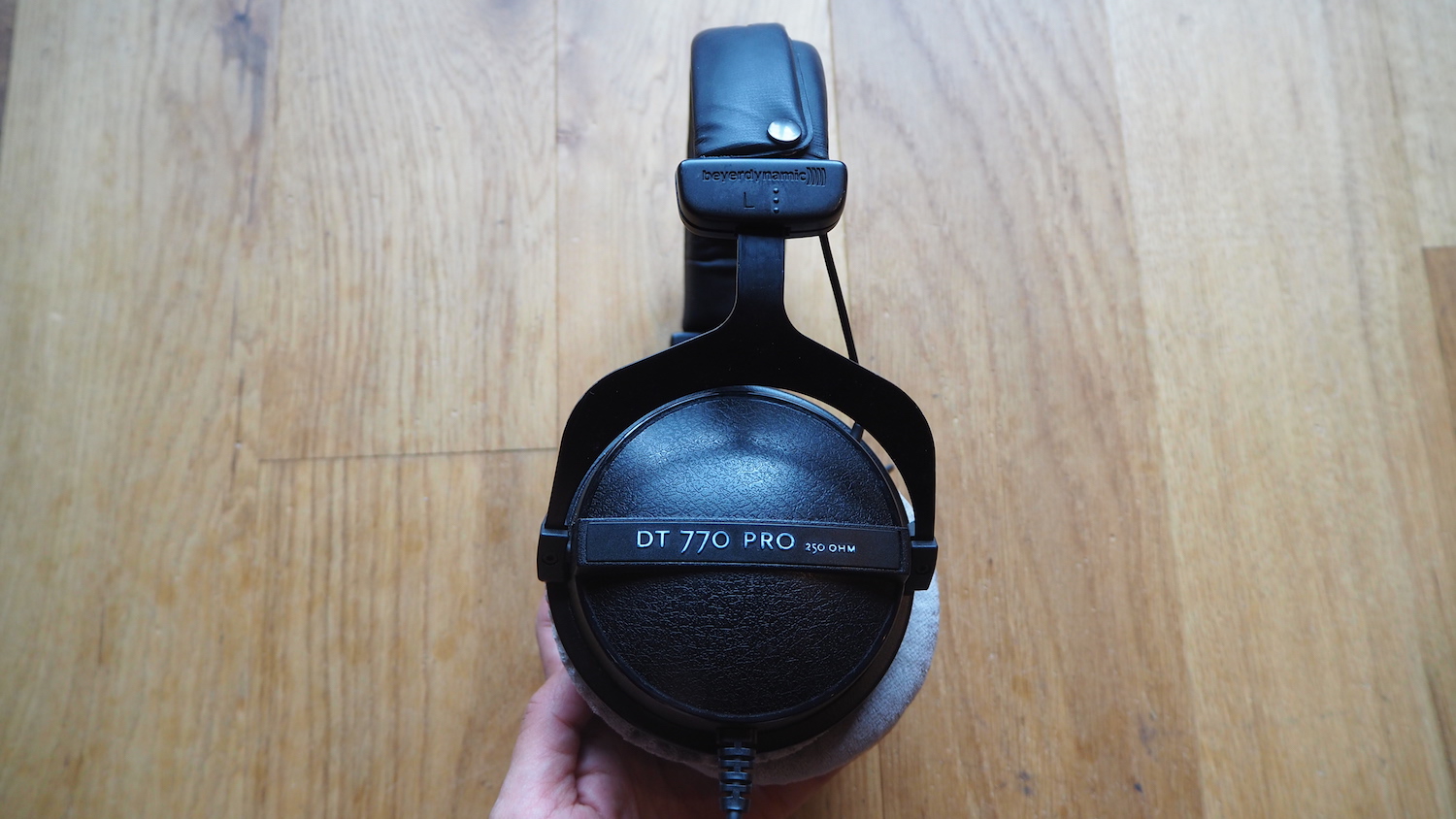

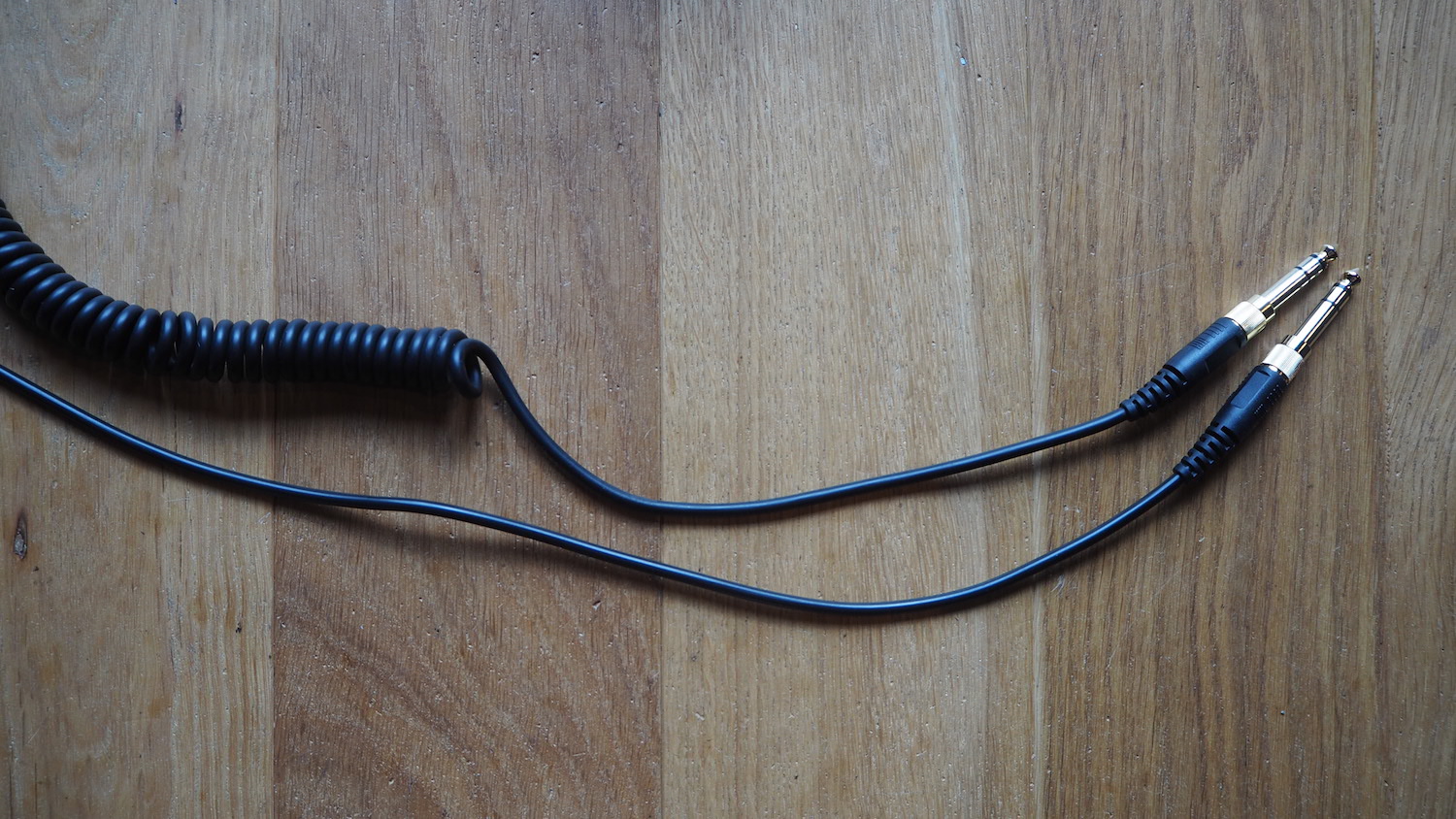
At Bax-shop (a Dutch retailer), the DT 770 250 Ohm are selling for €116, DT 990 Edition for €159 (and DT 990 Pro 250 Ohm €122).
At Thomann (a German retailer who sells worldwide), the DT 770 250 Ohm are selling for €122, DT 990 Edition for €159 (and DT 990 Pro 250 Ohm €122).
Buy the DT 770 Pro 250 Ohm: https://redir.love/vUOBW8oN
Buy the DT 990 Edition 250 Ohm: https://redir.love/qM1im3YD (not available anymore on Thomann but take a look at other products)
If price isn’t an issue and you’re currently comparing some other brands, for open-back, I can recommend Sennheiser HD650 (open) which are €354, more than twice the price of the DT 990 Edition, and are also very honest sounding and pleasurable to work with. For me, the DT 990 had a slightly more detailed sound and better spatial accuracy, which was more important to me than the frequency spectrum. (Sonarworks has a deal for €699 where you can buy the full software for headphones and speakers + the Sennheiser HD650. They also have a student/academic/educational discount so it is worth checking out). Some people might recommend headphones by AKG, but I’ve tried headphones from AKG and I don’t like the way they feel on my head. They feel less rugged and make a lot of noise when moving around on your ears.
Let me know in the comments if you have any other tips, or feedback on the above!
Click here to see the Beyerdynamic headphone range
—
If you’ve reached this far down of my blog post, please take a few seconds to:
Subscribe to my YouTube
Follow my Instagram
Like my Facebook







